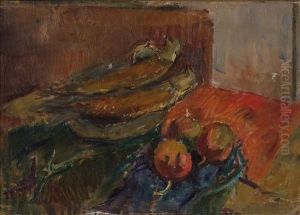Jerolim Mise Paintings
Jerolim Miše, a Croatian painter, was born in 1888 in the town of Komiža, on the island of Vis, which was then part of the Austro-Hungarian Empire. His early life in the picturesque, yet somewhat isolated island influenced his artistic sensibilities, imbuing his work with a sense of place and identity deeply rooted in the Adriatic culture. Miše's journey in art began at the local level, but his talent quickly propelled him to broader horizons.
After initial studies in Split, Miše furthered his education in fine arts at prestigious institutions in Vienna and Munich, which were vibrant centers for art and culture in the early 20th century. These experiences exposed him to a variety of artistic movements and techniques, including Impressionism, Expressionism, and the burgeoning Modernist movement, all of which would leave a mark on his evolving style. Despite these diverse influences, Miše's work retained a distinctive connection to his Dalmatian origins, often reflecting the landscape, people, and light of the Adriatic.
Miše's artistic career was marked by both innovation and tradition. He was adept at capturing the transient effects of light and color, a hallmark of Impressionism, yet his subjects were deeply traditional, often focusing on the everyday lives of fishermen, village scenes, and the rugged, sun-soaked coasts of his homeland. This blend of modern technique with traditional themes made his work uniquely appealing and positioned him as a significant figure in Croatian art during the first half of the 20th century.
Throughout his career, Jerolim Miše exhibited widely, both in Croatia and abroad, earning recognition and accolades for his contributions to art. His works are part of several public and private collections, testament to his enduring appeal and the universal qualities of his art that transcend regional boundaries. Miše continued to paint and contribute to the cultural life of Croatia until his death in 1952. Today, he is remembered as a pioneer who bridged the gap between traditional Croatian art and the broader currents of European modernism, leaving behind a legacy that continues to inspire and influence.
